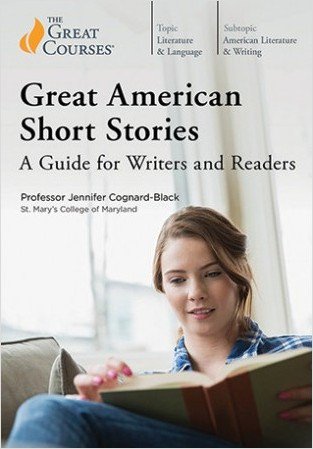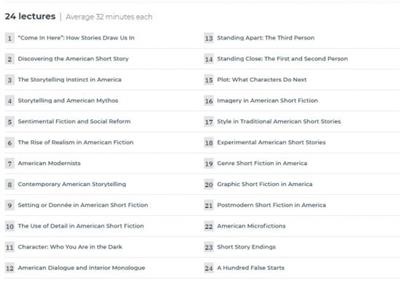Новости
|
 Автор: VnRuEn | Автор: VnRuEn |  Дата: 15 сентября 2019| Дата: 15 сентября 2019|  Просмотров: 0 Просмотров: 0
|
В разделе: - [Информация] |
|
 Video: .MP4, AVC, 1372 kbps, 960x540 | Audio: English, AAC, 128 kbps, 2 Ch | Duration: 12h 46m | 8.11 GB Course No. 2323 | Lecturer: Professor Jennifer Cognard-Black, Ph.D. | + PDF Guidebook Short stories offer readers the unique opportunity to experience a powerful piece of literature in a deceptively small package. The constraints of a few thousand words can give the best works an economy of storytelling that distills the power of the written word in astonishing ways. The brevity of short fiction belies its emotional and intellectual complexity.Show Full Description While short stories exist in traditions all over the world, American short stories are a genre all their own. Emerging from the clash of cultures-and the collision of oral and print traditions-that began during the arrival of European settlers in the 16th and 17th centuries, the short works that emerged have served many functions. They have entertained, certainly, but they have also helped foster identity, shape morality, and build the foundations of the American mythos for nearly four centuries. Whether you want to write short stories, simply want better insight as a reader, or even if you are looking for a new lens through which to view American history, the 24 rich and informative lectures of Great American Short Stories: A Guide for Writers and Readers will show you the ins and outs of this infinitely adaptable-and intrinsically American-literary form. Professor Jennifer Cognard-Black of St. Mary's College of Maryland guides you through the technical aspects of the short story, while also digging deep into the history of the form in the United States. Along the way, you will discover why the short story became so deeply connected to American identity and how it continues to evolve alongside the nation itself. American Mythos Literary traditions have helped shape American identity from the very beginning. When the United States established its independence from Britain, one of the earliest concerns of the new nation was creating a literature of its own, one free from the powerful influence of Europe. Writers tried their hand at many forms, but only one emerged as a patently American genre: the short story. Much like the nation itself, the American short story has continually changed and evolved to reflect the ideas, conflicts, and demographics of each era. After a brief introduction to the short story as a literary form, Professor Cognard-Black leads you through the evolution of the short story, beginning with the influence of the oral tradition in the earliest days of the American colonies, proceeding to the initial story experiments after the Revolutionary War, and then traversing the many changes in style and taste that have defined and redefined the genre with every new generation of Americans. Some of the prominent literary periods and styles you will tour include: Sentimental fiction. The early- to mid-19th century saw the rise of fiction that intentionally stirred emotion to sway readers' hearts and minds, utilizing sentiment as an effective tool in shaping the way Americans thought about slavery, temperance, class relations, social justice, and more. This period was also defined by the rising power of female writers. Realism. The school that would eventually be called realism held sway from the end of the Civil War and into World War I. Closely tied to the growth of print journalism across the nation, realism was a "boys' club" that resisted the activism of sentimental storytelling in favor of immediacy-even banality-to pursue truth that some writers saw as more democratic than earlier styles. Modernism. In the wake of World War I, many Americans were disillusioned about the state of the modern world. In response, this new school of writers turned away from realism, leaning in to an intentionally fragmented and artificial style that some considered more "literary" than realism, but that also managed to capture the rapidly changing, disorienting atmosphere of the early 20th century. These and other phases of literary production in America are reflective of the social and political climate of their time and place. As you progress from traditional stories into more experimental styles and genres, you will see how each generation tests the limits of the short story form. And, with guidance from Professor Cognard-Black, you will see how each of these loosely defined periods can give readers a unique view into the American character through fiction. Form and Function Storytelling has a direct influence on the brain, triggering the release of the feel-good chemical oxytocin. This chemical reaction means good stories affect us profoundly, giving stories immense power to influence how we see the world and the people in it. But this impact can only be maintained if readers truly believe in what they're experiencing, which is why the best short story writers manage to disappear from their work. Essentially, every aspect of a story must be tightly controlled and deeply considered, yet the author's fingerprints should be completely absent from the page. This invisibility on the part of the writer is accomplished through the many choices made when crafting a story. Even the most fantastic elements of a story need to feel true to life in order for readers to find a connection. So how do you use fiction to create a world that is believable-one that feels true but is also more interesting than the mundane realities of everyday life? And how do you make a short story feel like it contains an entire world over the course of just a few pages? The answer lies in how writers use the tools of the trade to create work that feels effortless, but actually requires a great deal of thought and planning. Some of the technical aspects to consider include: Setting/donnГ©e. The world in which the story takes place has to be immersive and believable. The donnГ©e ("that which is given") is not just the scenery, but the very fabric of the story; it is intrinsic to the characters themselves and their point of view. Character. Fictional characters must be both vital and true. In other words, you must not just show how your characters function in a given story but also find a way to reveal who they are when no one else is looking. Dialogue. Believable dialogue in fiction works differently than speech in the real world. Writers must tread a fine line between what is concise and engaging and what reads as true to life. Point of view. Who is telling the story? Is it told from the interior perspective of a single narrator? Does it step back and look at the larger picture? Point of view directly affects how readers engage with a story and where their sympathies lie. Style. Though difficult to define, style is at the core of what it means to be a storyteller. Essentially, it is the culmination of all the many aspects that define the craft and how each writer puts them to use in unique ways. As you will see throughout the lectures, these and other tools can be taught, but to truly understand them, you have to put them into practice. As Professor Cognard-Black says, "The only way to know the nuts and bolts, as well as the power, of American short stories is to read them; the only way to craft a story worth telling is to write them." Style and Substance Over the course of these lectures, you will be introduced to a range of writers who have shaped the American short story around the country and across generations. Beginning with the early sketches of Washington Irving, you will progress through the centuries to engage with work from writers of different styles, eras, origins, and levels of fame, including: Writers who use genre fiction to tell stories about the real world, like Edgar Allan Poe, Louisa May Alcott, and Ursula K. Le Guin; Authors who specialize in realist and naturalist stories, such as Mark Twain, Kate Chopin, and Edith Wharton, as well as more experimental authors like Jean Toomer and Donald Barthelme; Writers who have shaped the very fabric of literature in America, such as Ernest Hemingway and William Faulkner; and Contemporary short story writers that engage with the many complicated facets of the American experience, including Toni Morrison, Jhumpa Lahiri, and Annie Proulx. These authors and many, many more offer you an introduction to a wide range of small stories with big impact. And you will explore not just their stories, but also the larger movements and cultural influences that shaped their work and that have helped to make American short stories an ongoing, interconnected-and increasingly democratic-narrative of the American experience. The "great American novel" is often the lofty goal of writers who want to achieve literary immortality. But from the opening sentence to the lingering denouement, American short stories can both capture the world as it is and help envision what could be. Each is unique, and yet each is a part of a larger chronicle: the story of America. Homepage Screenshots   |
||
|
|
||

 TTC Video Great American Short Stories: A Guide for Readers and Writers
TTC Video Great American Short Stories: A Guide for Readers and Writers 